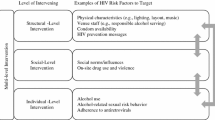Abstract
Better understanding the contribution of specific drinking contexts to alcohol use and risky sexual behaviors can help target effective prevention programs to specific locations and types of drinkers. We used a sample of college students to investigate whether more frequent and heavier drinking in specific drinking contexts was associated with unplanned sex, unprotected sex, and number of sexual contacts. Greater frequencies of drinking in almost all contexts (Greek parties, off-campus parties, campus events, dorms, and bars) were associated with greater numbers of sexual partners, unplanned sex and unprotected sex; heavier drinking at bars increased risks related to all outcomes. Risks related to frequencies of use of contexts were similar for men and women, but heavier drinking at bars was associated with more unprotected sex among males only. We discuss these observations in light of their implications for developing context-specific interventions to reduce community viral load in high-risk populations.
Similar content being viewed by others
References
Weinhardt LS, Carey MP. Does alcohol lead to sexual risk behavior? Findings from event-level research. Annu Rev Sex Res. 2000;11:125–57.
Wechsler H, Dowdall GW, Davenport A, Castillo S. Correlates of college student binge drinking. Am J Public Health. 1995;85(7):921–6.
Rehm J, Shield KD, Joharchi N, Shuper PA. Alcohol consumption and the intention to engage in unprotected sex: systematic review and meta-analysis of experimental studies. Addiction. 2012;107(1):51–9.
Baliunas D, Rehm J, Irving H, Shuper P. Alcohol consumption and risk of incident human immunodeficiency virus infection: a meta-analysis. Int J Public Health. 2010;55(3):159–66.
Stall R, Purcell DW. Intertwining epidemics: a review of research on substance use among men who have sex with men and its connection to the AIDS epidemic. AIDS Behav. 2000;4(2):181–92.
Woolf SE, Maisto SA. Alcohol use and risk of HIV infection among men who have sex with men. AIDS Behav. 2009;13(4):757–82.
Stueve A, O’Donnell L, Duran R, San Doval A, Geier J. Being high and taking sexual risks: findings from a multisite survey of urban young men who have sex with men. AIDS Educ Prev. 2002;14(6):482–95.
Cooper ML. Alcohol use and risky sexual behavior among college students and youth: evaluating the evidence. J Stud Alcohol Suppl. 2002;14:101–17.
Colfax G, Vittinghoff E, Husnik MJ, et al. Substance use and sexual risk: a participant-and episode-level analysis among a cohort of men who have sex with men. Am J Epidemiol. 2004;159(10):1002–12.
LaBrie JW, Hummer JF, Ghaidarov TM, Lac A, Kenney SR. Hooking up in the college context: the event-level effects of alcohol use and partner familiarity on hookup behaviors and contentment. J Sex Res. 2014;51(1):62–73.
Steele CM, Josephs RA. Alcohol myopia. Its prized and dangerous effects. Am Psychol. 1990;45(8):921–33.
Rohsenow DJ. Drinking habits and expectancies about alcohol’s effects for self versus others. J Consult Clin Psychol. 1983;51(5):752–6.
Darkes J, Goldman MS. Expectancy challenge and drinking reduction: process and structure in the alcohol expectancy network. Exp Clin Psychopharmacol. 1998;6(1):64–76.
Frost SD. Using sexual affiliation networks to describe the sexual structure of a population. Sex Transm Infect. 2007;83(Suppl 1):i37–42.
Newman ME, Watts DJ, Strogatz SH. Random graph models of social networks. Proc Natl Acad Sci USA. 2002;99(Suppl 1):2566–72.
Gruenewald PJ, Remer LG, LaScala EA. Testing a social ecological model of alcohol use: the California 50-city study. Addiction. 2014;109(5):736–45.
Gruenewald PJ. The spatial ecology of alcohol problems: niche theory and assortative drinking. Addiction. 2007;102(6):870–8.
Jaffe HW, Valdiserri RO, De Cock KM. The reemerging HIV/AIDS epidemic in men who have sex with men. JAMA. 2007;298(20):2412–4.
Castel AD, Befus M, Willis S, Griffin A, West T, Hader S, et al. Use of the community viral load as a population-based biomarker of HIV burden. AIDS. 2012;26(3):345–53.
Mair C, Cunradi CB, Gruenewald PJ, Todd M, Remer L. Drinking context-specific associations between intimate partner violence and frequency and volume of alcohol consumption. Addiction. 2013;108(12):2102–11.
Saltz RF, Paschall MJ, McGaffigan RP, Nygaard PM. Alcohol risk management in college settings: the Safer California Universities randomized trial. Am J Prev Med. 2010;39(6):491–9.
Freisthler B, Gruenewald PJ. Where the individual meets the ecological: a study of parent drinking patterns, alcohol outlets and child physical abuse. Alcohol Clin Exp Res. 2013;37(6):993–1000.
Gruenewald PJ, Johnson FW, Ponicki WR, Lascala EA. A dose-response perspective on college drinking and related problems. Addiction. 2010;105(2):257–69.
Gruenewald PJ, Mair C. Heterogeneous dose-response and college student drinking: examining risks related to low drinking levels. Addiction. 2015;110(6):945–54.
Lewis MA, Lee CM, Patrick ME, Fossos N. Gender-specific normative misperceptions of risky sexual behavior and alcohol-related risky sexual behavior. Sex Roles. 2007;57(1–2):81–90.
Giancola PR, Levinson CA, Corman MD, Godlaski AJ, Morris DH, Phillips JP, et al. Men and women, alcohol and aggression. Exp Clin Psychopharmacol. 2009;17(3):154–64.
Davis KC, Norris J, George WH, Martell J, Heiman JR. Men’s likelihood of sexual aggression: the influence of alcohol, sexual arousal, and violent pornography. Aggress Behav. 2006;32(6):581–9.
Jones-Webb R, Smolenski D, Brady S, Wilkerson M, Rosser BR. Drinking settings, alcohol consumption, and sexual risk behavior among gay men. Addict Behav. 2013;38(3):1824–30.
Acknowledgments
Research for and preparation of this manuscript were supported by National Institute on Alcohol Abuse and Alcoholism Grants R21-AA021438 to the first author and P60-AA006282 to the co-author (Gruenewald).
Author information
Authors and Affiliations
Corresponding author
Rights and permissions
About this article
Cite this article
Mair, C., Ponicki, W.R. & Gruenewald, P.J. Reducing Risky Sex Among College Students: Prospects for Context-Specific Interventions. AIDS Behav 20 (Suppl 1), 109–118 (2016). https://doi.org/10.1007/s10461-015-1147-2
Published:
Issue Date:
DOI: https://doi.org/10.1007/s10461-015-1147-2




